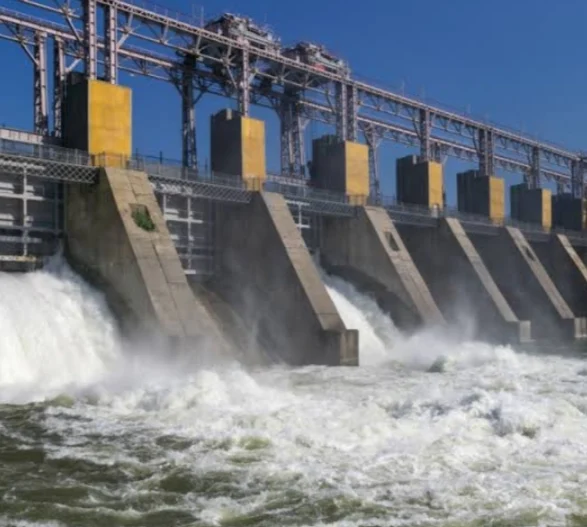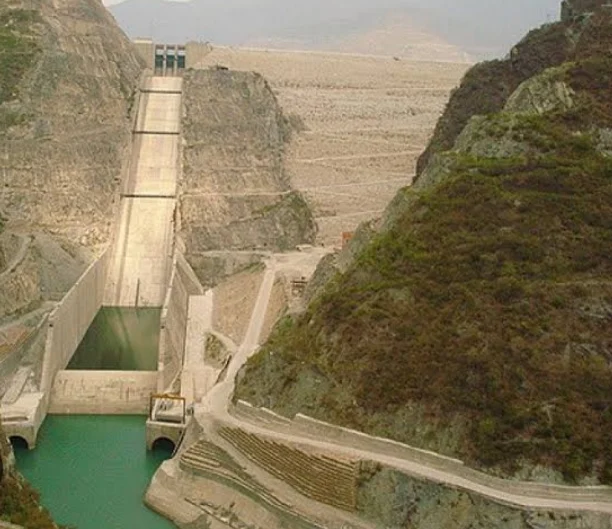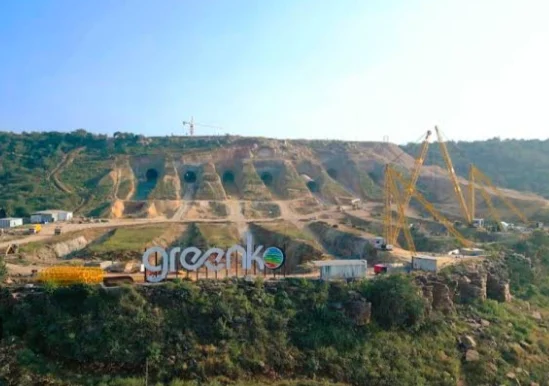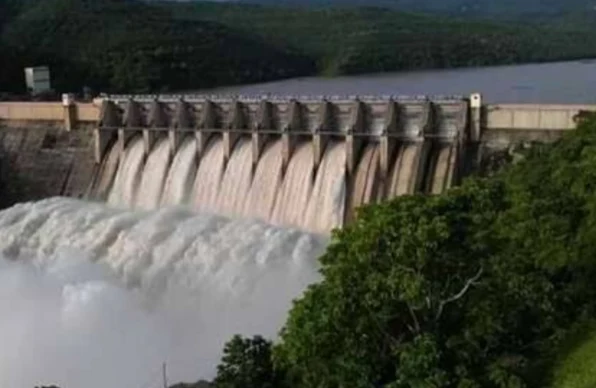A Timeline of the Pinnapuram Integrated Renewable Energy Project (IREP)
2016-2017:
- Conception: Greenko Group proposes the Pinnapuram IREP concept, envisioning it as India's first and one of the world's largest integrated renewable energy projects.
- Initial Planning: Feasibility studies conducted, environmental assessments initiated, and discussions with potential investors begun.
2018-2019:
- Project Gaining Momentum: Greenko secures land acquisition agreements for the project site in Kurnool district, Andhra Pradesh.
- Financial Backing Solidifies: The World Bank expresses interest in the project, followed by the Asian Development Bank and the Indian Green Climate Fund.
- Technology Partnerships Formed: Collaboration with international companies like AFRY, Voith, and Andritz Hydro begins for specific project components.
2020-2021:
- Construction Commences: The first phase of the project, a 1 GW solar power plant, starts construction.
- Financial Closure Achieved: Greenko raises necessary funds through debt from the World Bank and ADB, equity injections from partners, and internal resources.
- Regulatory Approvals Obtained: Environmental and other regulatory clearances secured from the Indian government.
2022-2023:
- Solar Plant Operational: The 1 GW solar power plant within Pinnapuram IREP becomes operational, marking a significant milestone.
- Construction Progress: Work on the wind farm and pumped storage hydropower components progresses steadily.
- Increased Recognition: The project receives international attention as a pioneering initiative in renewable energy integration.
2024-2026 (Anticipated):
- Continued Construction: Remaining phases of the project, including the wind farm and pumped storage hydro facility, are expected to be completed by 2026.
- Full Capacity Operational: Upon completion, Pinnapuram IREP is expected to become the world's largest integrated renewable energy project with a total capacity of 5,230 MW.
- Impact Realized: The project is projected to provide clean energy to millions of homes, create thousands of jobs, and significantly contribute to India's renewable energy goals.
Beyond 2026:
- Potential Model: Pinnapuram IREP holds the potential to become a model for future integrated renewable energy projects globally, showcasing the benefits of collaboration, innovation, and sustainable energy solutions.
- Continued Development: Greenko may explore further expansion of the Pinnapuram IREP with additional renewable energy components or grid-integration projects.
This timeline provides a brief overview of the key milestones and phases in the history of the Pinnapuram IREP. As the project progresses, its impact on India's energy landscape and the future of renewable energy is expected to become even more significant.
Outlook of Pinnapuram Integrated Renewable Energy Project, India
This ambitious project, combining solar, wind, and pumped storage hydropower, promises to deliver dispatchable and schedulable renewable energy on a grand scale, potentially transforming India's energy future.
A Glimpse into the Project's Brilliance:
- World's First of its Kind: Pinnapuram IREP aspires to be the world's first and largest integrated renewable energy project with such a comprehensive setup. This pioneering blend of technologies aims to overcome the intermittency challenges inherent in solar and wind power, paving the way for a more reliable and flexible renewable energy source.
- Schedulable Power on Demand (SPOD): The project's ability to generate "Schedulable Power on Demand" (SPOD) is its key differentiator. By integrating pumped storage hydro with solar and wind, Pinnapuram IREP can store excess energy during periods of high generation and release it on demand during peak demand periods, mimicking the functionality of traditional fossil fuel power plants. This capability is crucial for grid stability and integration of large-scale renewables.
- Massive Generation Capacity: Upon completion, Pinnapuram IREP is expected to boast a staggering capacity of 1.2 GW of solar, 1.2 GW of wind, and 1.2 GW of pumped storage hydro, translating to a total generation of up to 7 billion units of electricity annually. This output is enough to power millions of homes and significantly contribute to India's renewable energy targets.
Project Status and Future Prospects:
- Current Stage: The project is currently in its initial phase, with the 1 GW solar power plant already operational. Construction of the wind and pumped storage hydro components is well underway, with anticipated completion by 2026.
- Overcoming Challenges: As with any large-scale infrastructure project, Pinnapuram IREP faces its share of challenges. Environmental concerns, land acquisition issues, and the high initial investment costs require careful consideration and mitigation strategies.
- Economic and Environmental Benefits: Despite the challenges, the potential benefits of Pinnapuram IREP are undeniable. The project is expected to create thousands of jobs, boost local economies, and contribute significantly to India's clean energy goals. Additionally, by reducing reliance on fossil fuels, it will help mitigate climate change and improve air quality.
A Beacon for India's Renewable Energy Future:
The Pinnapuram Integrated Renewable Energy Project stands as a beacon of hope for India's renewable energy future. Its success could pave the way for similar projects across the country, accelerating the transition towards a cleaner and more sustainable energy landscape. While challenges remain, the potential rewards are immense, making Pinnapuram IREP a project to watch closely in the years to come.
Additional Points to Consider:
- The project is being developed by Greenko Group, a leading Indian renewable energy company.
- Pinnapuram IREP has received financial backing from multiple institutions, including the World Bank and the Asian Development Bank.
- The project is expected to play a key role in helping India achieve its ambitious renewable energy targets of 450 GW by 2030 and 500 GW by 2050.
Pinnapuram Integrated Renewable Energy Project, India: Financial and International Support
Pinnapuram Integrated Renewable Energy Project: Financial and International Support
Financial Backbone:
-
Greenko Group:
- Leading Indian renewable energy company spearheading the project.
- Committed to clean energy and has a track record of successful projects.
-
Financial Institutions:
- World Bank: $450 million committed through its Private Infrastructure Development Fund.
- Asian Development Bank: $300 million loan provided for project development.
- Indian Green Climate Fund: Additional financial support for climate-resilient infrastructure.
-
Equity Partners:
- Greenko has secured investments from equity partners in India and the Middle East to further strengthen financial resources.
International Collaboration:
-
Technology Providers:
- AFRY (Sweden): Detailed design engineering services for the 1.2 GW pumped storage component.
- Voith (Germany): Turbines and generators for the pumped storage facility.
- Andritz Hydro (Austria): Construction of dams and waterways.
-
Knowledge Sharing:
- International partnerships facilitate knowledge exchange and best practices in developing and managing large-scale renewable projects.
Additional Data:
- Total Project Capacity: 5,230 MW (aggregate)
- Solar: 1,200 MW
- Wind: 1,200 MW
- Pumped Storage Hydro: 1,680 MW
- Annual Electricity Generation: Up to 7 billion units
- Anticipated Completion: 2026
- Estimated Project Cost: $3 billion
- Jobs Created: Estimated 10,000 during construction, 2,000 permanent jobs
- Carbon Emission Reduction: Over 15 million tons annually
Moving Forward:
- Securing continued financial support, addressing environmental concerns, and navigating land acquisition issues remain crucial challenges.
- The project's success will hinge on effective collaboration, innovative solutions, and a commitment to sustainability.
- Pinnapuram IREP has the potential to serve as a model for future integrated renewable energy projects globally, demonstrating the power of international cooperation in shaping a cleaner energy future.
Technology of the Pinnapuram Integrated Renewable Energy Project (IREP), India
The Pinnapuram IREP is a marvel of technological innovation, seamlessly integrating multiple renewable energy sources to deliver dispatchable and schedulable power on demand (SPOD).
Let's dive into the key technologies powering this groundbreaking project:
1. Solar Power:
-
High-Efficiency Photovoltaic Panels: Pinnapuram IREP utilizes cutting-edge solar panels with high conversion efficiency, maximizing energy capture from sunlight. Think advanced silicon panels like bifacial modules that capture light from both sides, potentially boosting output by 10-20%.
Single-Axis Tracking Systems: These intelligent systems dynamically adjust the position of the solar panels throughout the day to track the sun's movement, optimizing energy generation by 20-30% compared to fixed panels.
-
Advanced Inverters: Sophisticated inverters convert the direct current (DC) from the solar panels into alternating current (AC) grid-compatible electricity, ensuring efficient and stable power output.
2. Wind Power:
-
High-Capacity Wind Turbines: The project will deploy modern wind turbines with larger blades and higher capacity (likely in the 3-5 MW range) to maximize wind energy harvesting, particularly in the semi-arid climate of Andhra Pradesh.
-
Lidar Technology: Light Detection and Ranging (LiDAR) systems provide real-time wind speed and direction data, allowing for intelligent turbine control and maximizing energy generation efficiency.
-
Grid Integration Systems: Advanced grid integration systems ensure seamless connection of the wind farm to the electricity grid, managing fluctuations and stabilizing power supply.
3. Pumped Storage Hydropower:
-
Reservoir Creation: Two reservoirs are being constructed in existing natural depressions using low-height embankments. The upper reservoir stores water during periods of excess renewable energy generation.
-
Turbine-Generator System: During peak demand periods, water is released from the upper reservoir to the lower reservoir, driving powerful turbines and generators to produce electricity on demand.
-
Advanced Pump System: During periods of low energy demand or excess renewable generation, electricity is used to pump water back to the upper reservoir, storing potential energy for future use.
Technological Integration:
The true brilliance of Pinnapuram IREP lies in its seamless integration of these diverse technologies. An intelligent central control system monitors energy generation from all sources, optimizes the use of the pumped storage facility, and ensures stable and reliable power delivery to the grid.
Additional Tech Highlights:
- IoT-based Monitoring and Control Systems: Sensors and intelligent software constantly monitor the performance of all project components, enabling predictive maintenance and optimizing energy output.
- Advanced Weather Forecasting Systems: Real-time weather data helps optimize energy generation and storage based on anticipated wind and solar resource availability.
- Cybersecurity Measures: Robust cybersecurity measures safeguard the project's critical infrastructure and data from potential cyberattacks.
The Pinnapuram IREP exemplifies cutting-edge technologies working in concert to create a new paradigm for renewable energy generation and delivery. Its success paves the way for a cleaner and more sustainable future powered by innovative solutions.
Note: While specific details about the exact technologies used are not publicly available, the descriptions above provide a general overview of the key technologies likely employed in the project.
Statistics Data of Pinnapuram Integrated Renewable Energy Project (IREP), India
Pinnapuram Integrated Renewable Energy Project (IREP): Statistics Data
Project Capacity:
- Total: 5,230 MW (aggregate)
- Solar: 1,200 MW
- Wind: 1,200 MW
- Pumped Storage Hydro: 1,680 MW (1.3 TWh storage capacity)
Annual Electricity Generation:
- Up to 7 billion units
Anticipated Completion:
- 2026
Estimated Project Cost:
- $3 billion
Jobs Created:
- Estimated 10,000 during construction
- 2,000 permanent jobs
Carbon Emission Reduction:
- Over 15 million tons annually
Other Statistics:
- Land Acquisition: 5,400 hectares
- Construction Area: 16,000 hectares
- Transmission Line Length: 500 km (planned)
- Number of Turbines:
- Wind: Approximately 240 (based on typical 5 MW capacity)
- Pumped Storage Hydro: 4 (2 units per reservoir)
- Reservoir Capacity: 2 x 1.3 TWh (upper and lower reservoirs)
- Project Developer: Greenko Group
Financial Backing:
- World Bank: $450 million
- Asian Development Bank: $300 million
- Indian Green Climate Fund: Additional support
- Equity Partners: Investments from India and the Middle East
Technology Highlights:
- High-efficiency solar panels
- Single-axis tracking systems
- Advanced inverters
- High-capacity wind turbines
- Lidar technology
- Pumped storage hydropower with advanced turbines and pumps
- Central control system for integrated energy management
- IoT-based monitoring and control systems
- Advanced weather forecasting systems
- Robust cybersecurity measures
Please note: This data is based on publicly available information and may be subject to change.
Table of Pinnapuram Integrated Renewable Energy Project (IREP) Data Summary
| Category | Data |
|---|---|
| Project Capacity | 5,230 MW (aggregate) |
| - Solar: 1,200 MW | |
| - Wind: 1,200 MW | |
| - Pumped Storage Hydro: 1,680 MW (1.3 TWh storage capacity) | |
| Annual Electricity Generation | Up to 7 billion units |
| Anticipated Completion | 2026 |
| Estimated Project Cost | $3 billion |
| Jobs Created | - Estimated 10,000 during construction |
| - 2,000 permanent jobs | |
| Carbon Emission Reduction | Over 15 million tons annually |
| Other Statistics | - Land Acquisition: 5,400 hectares |
| - Construction Area: 16,000 hectares | |
| - Transmission Line Length: 500 km (planned) | |
| - Number of Turbines: | |
| - Wind: Approximately 240 (based on typical 5 MW capacity) | |
| - Pumped Storage Hydro: 4 (2 units per reservoir) | |
| - Reservoir Capacity: 2 x 1.3 TWh (upper and lower reservoirs) | |
| - Project Developer: Greenko Group | |
| Financial Backing | - World Bank: $450 million |
| - Asian Development Bank: $300 million | |
| - Indian Green Climate Fund: Additional support | |
| - Equity Partners: Investments from India and the Middle East | |
| Technology Highlights | - High-efficiency solar panels |
| - Single-axis tracking systems | |
| - Advanced inverters | |
| - High-capacity wind turbines | |
| - Lidar technology | |
| - Pumped storage hydropower with advanced turbines and pumps | |
| - Central control system for integrated energy management | |
| - IoT-based monitoring and control systems | |
| - Advanced weather forecasting systems | |
| - Robust cybersecurity measures |
Conclusion: Pinnapuram IREP - A Beacon for India's Renewable Energy Future
The Pinnapuram Integrated Renewable Energy Project (IREP) stands as a groundbreaking testament to India's ambition in transitioning towards a cleaner and more sustainable energy future.
More than just a massive renewable energy project, Pinnapuram IREP represents a paradigm shift in energy generation and delivery, with its:
- Integrated Approach: Seamlessly combining solar, wind, and pumped storage hydro, the project defies the intermittency challenges of traditional renewables, offering dispatchable and schedulable power on demand.
- Technological Innovation: Cutting-edge technologies like high-efficiency panels, advanced wind turbines, and intelligent control systems maximize energy generation and ensure grid stability.
- Financial and International Support: Backing from institutions like the World Bank and ADB, along with collaboration with leading technology providers, demonstrates global confidence in the project's potential.
- Environmental and Economic Benefits: IREP promises clean energy for millions, substantial carbon emission reduction, and job creation, boosting local economies and contributing to India's green goals.
While challenges remain, including land acquisition and ongoing construction, the successful completion of Pinnapuram IREP will have far-reaching implications. It can:
- Model for Integrated Renewables: Showcase the viability and benefits of integrated renewable energy systems, paving the way for similar projects across India and the world.
- Grid Modernization: Strengthen and stabilize the Indian grid, enabling wider adoption of renewables and facilitating a cleaner energy mix.
- Energy Security and Independence: Reduce reliance on fossil fuels and enhance India's energy security, promoting self-sufficiency and resilience.
Pinnapuram IREP is not just a project; it's a symbol of hope and progress. Its success will not only power millions of homes but also illuminate the path towards a cleaner and more sustainable future for India and the world. The project's legacy will lie in its ability to inspire, innovate, and catalyze a global shift towards renewable energy solutions, leaving a lasting impact on the planet and generations to come.
Frequently Asked Questions About the Pinnapuram Integrated Renewable Energy Project (IREP)
General Questions
- What is the Pinnapuram IREP?
- It's a large-scale, integrated renewable energy project being developed in Andhra Pradesh, India.
- What type of renewable energy does it use?
- IREP combines solar, wind, and pumped storage hydroelectric power.
- Why is it significant?
- It's expected to be one of the world's largest integrated renewable energy projects, providing dispatchable and schedulable renewable energy to consumers across India.
- It's expected to be one of the world's largest integrated renewable energy projects, providing dispatchable and schedulable renewable energy to consumers across India.
Specific Questions
- Where is the project located?
- It's located in Pinnapuram village, Kurnool district, Andhra Pradesh.
- What is the total capacity of the project?
- The project has a total capacity of 3.6 GW, consisting of:
- 2 GW solar power
- 400 MW wind power
- 1.2 GW pumped storage hydroelectric power
- The project has a total capacity of 3.6 GW, consisting of:
- How does pumped storage work in this project?
- The project will utilize two reservoirs to store excess energy during peak production periods and release it during off-peak hours or when demand is high.
- The project will utilize two reservoirs to store excess energy during peak production periods and release it during off-peak hours or when demand is high.
Additional Questions
- What are the benefits of this project?
- The project offers several benefits, including:
- Clean energy: It will reduce India's reliance on fossil fuels and contribute to a cleaner environment.
- Energy security: It will help India meet its growing energy demand while reducing its dependence on imported energy.
- Economic development: The project is expected to create jobs and boost the local economy.
- Clean energy: It will reduce India's reliance on fossil fuels and contribute to a cleaner environment.
- The project offers several benefits, including:
- What is the timeline for the project?
- While specific timelines may vary, the project is expected to be completed in phases over several years.
- While specific timelines may vary, the project is expected to be completed in phases over several years.
- Are there any environmental concerns associated with the project?
- As with any large-scale development project, there may be environmental concerns, such as land use and potential impacts on local ecosystems. However, the project developers are likely to implement measures to mitigate these concerns.
- As with any large-scale development project, there may be environmental concerns, such as land use and potential impacts on local ecosystems. However, the project developers are likely to implement measures to mitigate these concerns.







